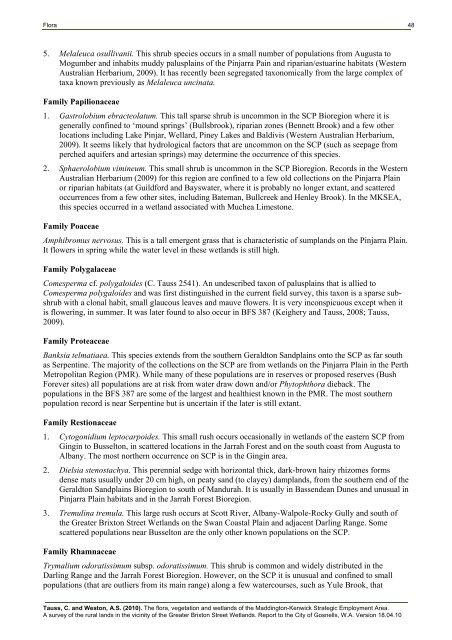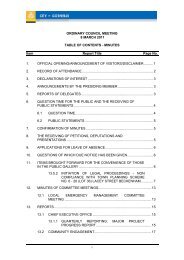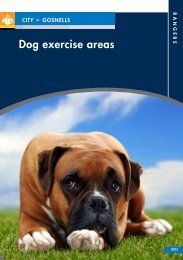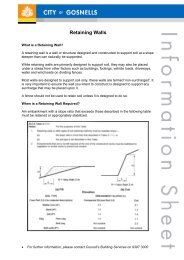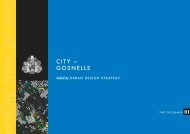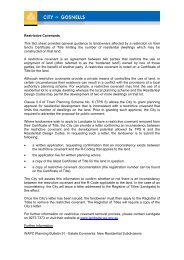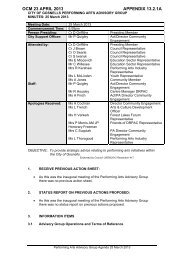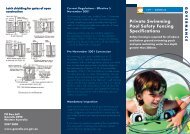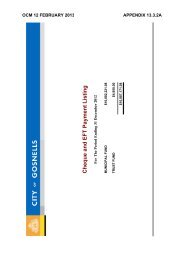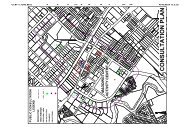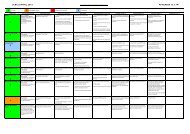Summary - City of Gosnells
Summary - City of Gosnells
Summary - City of Gosnells
You also want an ePaper? Increase the reach of your titles
YUMPU automatically turns print PDFs into web optimized ePapers that Google loves.
Flora 485. Melaleuca osullivanii. This shrub species occurs in a small number <strong>of</strong> populations from Augusta toMogumber and inhabits muddy palusplains <strong>of</strong> the Pinjarra Pain and riparian/estuarine habitats (WesternAustralian Herbarium, 2009). It has recently been segregated taxonomically from the large complex <strong>of</strong>taxa known previously as Melaleuca uncinata.Family Papilionaceae1. Gastrolobium ebracteolatum. This tall sparse shrub is uncommon in the SCP Bioregion where it isgenerally confined to ‘mound springs’ (Bullsbrook), riparian zones (Bennett Brook) and a few otherlocations including Lake Pinjar, Wellard, Piney Lakes and Baldivis (Western Australian Herbarium,2009). It seems likely that hydrological factors that are uncommon on the SCP (such as seepage fromperched aquifers and artesian springs) may determine the occurrence <strong>of</strong> this species.2. Sphaerolobium vimineum. This small shrub is uncommon in the SCP Bioregion. Records in the WesternAustralian Herbarium (2009) for this region are confined to a few old collections on the Pinjarra Plainor riparian habitats (at Guildford and Bayswater, where it is probably no longer extant, and scatteredoccurrences from a few other sites, including Bateman, Bullcreek and Henley Brook). In the MKSEA,this species occurred in a wetland associated with Muchea Limestone.Family PoaceaeAmphibromus nervosus. This is a tall emergent grass that is characteristic <strong>of</strong> sumplands on the Pinjarra Plain.It flowers in spring while the water level in these wetlands is still high.Family PolygalaceaeComesperma cf. polygaloides (C. Tauss 2541). An undescribed taxon <strong>of</strong> palusplains that is allied toComesperma polygaloides and was first distinguished in the current field survey, this taxon is a sparse subshrubwith a clonal habit, small glaucous leaves and mauve flowers. It is very inconspicuous except when itis flowering, in summer. It was later found to also occur in BFS 387 (Keighery and Tauss, 2008; Tauss,2009).Family ProteaceaeBanksia telmatiaea. This species extends from the southern Geraldton Sandplains onto the SCP as far southas Serpentine. The majority <strong>of</strong> the collections on the SCP are from wetlands on the Pinjarra Plain in the PerthMetropolitan Region (PMR). While many <strong>of</strong> these populations are in reserves or proposed reserves (BushForever sites) all populations are at risk from water draw down and/or Phytophthora dieback. Thepopulations in the BFS 387 are some <strong>of</strong> the largest and healthiest known in the PMR. The most southernpopulation record is near Serpentine but is uncertain if the later is still extant.Family Restionaceae1. Cytogonidium leptocarpoides. This small rush occurs occasionally in wetlands <strong>of</strong> the eastern SCP fromGingin to Busselton, in scattered locations in the Jarrah Forest and on the south coast from Augusta toAlbany. The most northern occurrence on SCP is in the Gingin area.2. Dielsia stenostachya. This perennial sedge with horizontal thick, dark-brown hairy rhizomes formsdense mats usually under 20 cm high, on peaty sand (to clayey) damplands, from the southern end <strong>of</strong> theGeraldton Sandplains Bioregion to south <strong>of</strong> Mandurah. It is usually in Bassendean Dunes and unusual inPinjarra Plain habitats and in the Jarrah Forest Bioregion.3. Tremulina tremula. This large rush occurs at Scott River, Albany-Walpole-Rocky Gully and south <strong>of</strong>the Greater Brixton Street Wetlands on the Swan Coastal Plain and adjacent Darling Range. Somescattered populations near Busselton are the only other known populations on the SCP.Family RhamnaceaeTrymalium odoratissimum subsp. odoratissimum. This shrub is common and widely distributed in theDarling Range and the Jarrah Forest Bioregion. However, on the SCP it is unusual and confined to smallpopulations (that are outliers from its main range) along a few watercourses, such as Yule Brook, thatTauss, C. and Weston, A.S. (2010). The flora, vegetation and wetlands <strong>of</strong> the Maddington-Kenwick Strategic Employment Area.A survey <strong>of</strong> the rural lands in the vicinity <strong>of</strong> the Greater Brixton Street Wetlands. Report to the <strong>City</strong> <strong>of</strong> <strong>Gosnells</strong>, W.A. Version 18.04.10


